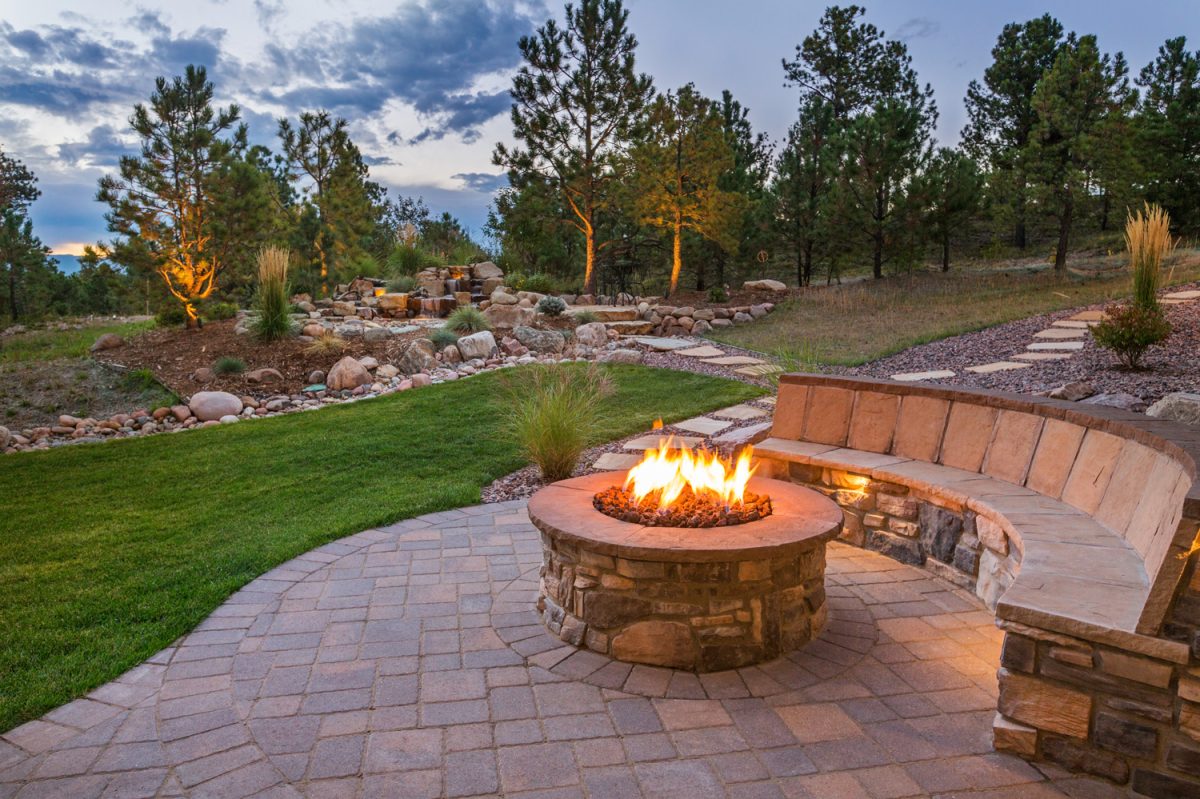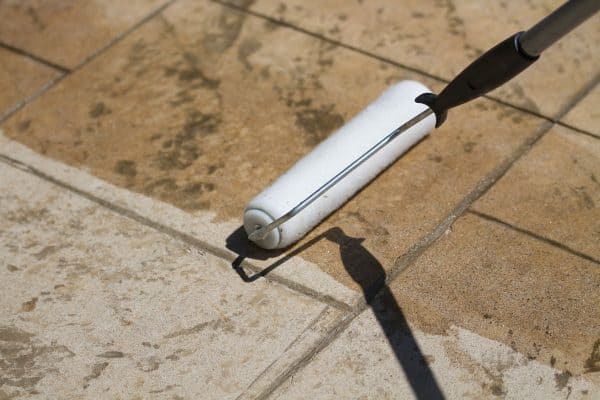Disclosure: We may get commissions for purchases made through links in this post.
Flagstone designed for outdoor projects is thick and heavy, making it more durable than other types of surfaces. So is it still necessary to seal it? We did thorough research, and here's what we found.
Yes, outdoor flagstone must be sealed to protect its integrity. A sealer fills in the pores, creating a hard and durable surface, especially as flagstone exposed to different environmental factors such as moisture, wind, etc., can fade and even warp early.
We now know that sealing outdoor flagstone is crucial. But what sealer should you use, and can the application be done by yourself? We’ll cover that in detail next, so read more!

Sealant: What Is It?

Sealants are liquid agents made to create a protective barrier on pavers to deter water and stains. They also make pavers easier to clean, bring out their natural beauty, and extend their lifespan. The two most popular flagstone sealers are silane siloxane sealers and acrylic sealers.
Silane siloxane sealers are water-repellent, breathable, and contain advanced waterproofing properties. They penetrate deep into the substrate, blocking moisture and petroleum spills. Also, they deter mold or mildew growth and keep efflorescence at bay. The downside is they are expensive.
Check out this product on Amazon.
Acrylic sealants are the by-product of acrylic resins that are viable options for filling gaps and cracks on walkways to prevent rain from seeping underneath. They are easy to dry and are paintable. But they wear out faster, so touching up every 1 to 4 years is vital.
Click here to see this product on Amazon.
Why Sealing Outdoor Flagstone Is Not Optional?
Flagstone is porous and absorbent by nature. Moreover, it has stone layering that traps water, making it vulnerable to cracking and flaking. But sealing makes it impermeable.
What Do You Get from Sealing Flagstone?
Sealing outdoor flagstone has a number of benefits and drawbacks:
Benefits
- Makes stones more durable - Sealants add a second layer of protection against weathering, moisture, and foot traffic, thus increasing flagstone durability.
- Improves aesthetic - A sealer helps to bring out the natural color of the stones. Also, it gives the patio a wet look and glossy finish, depending on the type of sealer used. Because it resists stain, it keeps the patio tidy-looking.
- Protects foundation - As we’ve mentioned, porous substances trap moisture underneath them, making it difficult to build a solid foundation as it’s almost impossible to remove the water from underneath. Sealant ensures they are dry and intact.
Drawbacks
- Maintenance - Once sealed, the flagstone is to be resealed regularly. The frequency depends on how thick the sealant is and the exposure of flagstone to different environmental factors.
- Costly - We suggest quality sealers that are likely to last up to 10 years, despite extreme temperatures and foot traffic. But, they are relatively expensive. The price starts at $200.
- Plant contamination - Sealants contain Volatile Organic Compounds (VCOs) that spread in the air and contaminate nearby plants. Protect potted plants with plastic during the application process.
How To Seal Outdoor Flagstone

Follow these step-by-step instructions to seal flagstone:
- Pressure wash the flagstone first to remove any debris that can prevent the sealant from sticking.
- Allow the surface to dry.
- Apply one to two coats. This serves as the first coating. Let it dry overnight.
- Seal the gaps with grout. Make sure to follow the instructions on the product. Allow it to dry. (This is inapplicable on sealant-grout.)
- Apply the second coating over the grout. The curing stage can take 10 to 15 days. Avoid any foot traffic during the process.
Should You Seal Flagstone Around The Pool?
Yes, you should also seal the flagstone around your pool. This shields them from water, minimizing the damage and other issues associated with dampness, particularly, mold and discoloration.
Sealing the flagstone with three layers or more is advisable as it is more prone to moisture. Ensure that all gaps are sealed; otherwise, it will lead to more serious structural defects which can cost you more.
How Often Should You Reseal Your Outdoor Flagstone?
As we have discussed, the quality of the sealer affects how often should you reseal the flagstone. But resealing every three to four years is recommended. That can offset costly repairs.
Is Sealed Flagstone Slippery When Wet?
A wrong sealant can make flagstone slippery, particularly when wet. So make sure that you only use sealants made specifically for flagstone or risk slips and falls.
How To Fill Gaps On Flagstone

Before anything else, choose the material to fill your flagstone joints with:
- Polymeric sand - is a safe, efficient product used to fill paver joints to prevent shifting. But it can be overlaid on natural stones. It comes with color variations that create distinct features and complement both traditional and modern decks and patio.
- Regular sand - is the alternative to polymeric sand. It contains silica and other minerals.
- Crushed rocks - these can also be used to fill in gaps between flagstones. You can opt for small or large rocks, depending on the space between your flagstones.
- Mulch - this creates a rich, dark contrast to neutral-toned flagstones and is an effective way of creating a beautiful patio. It also keeps weeds and pests at bay.
- Plants - Using ground cover plants is an eco-friendly way to fill space between stones. Turf is one of the most popular options and suits larger spaces.
Follow these steps below to fill gaps on the flagstone. We’ll use polymeric sand as this is the first choice of most homeowners.
- Make sure that there’s no rain forecast; polymeric sand can’t get rained on 24 hours after the application.
- Check if the ground is wet; polymeric sand won’t harden up if moisture is present.
- Pour the sand over the surface, then fill each gap with the broom. Ensure that they are leveled.
- Compact the sand, refill the joints, then vibrate with a plate compactor again.
- Remove the residue or dust on the stones to avoid polyhaze during the curing process. You can use a leaf blower.
- Water the sand. After 2 to 3 minutes, shower the sand again.
- Blow the sand that trickles out.
- Allow the surface to dry for 24 hours. But avoid any foot traffic for at least 72 hours.
- Inspect if the sand settles properly.
How To Maintain Flagstone
Here's how to maintain flagstone properly:
Clean Periodicly
To keep your flagstone in the best condition possible, you should clean it on a regular basis. Leaves and oil spills must be removed quickly as they leave stains on the stones.
Use Mild Solutions
You should also consider what you’re cleaning them with to prevent deterioration. Bleach and muriatic acid diluted in water make the best options. Avoid using acidic solutions as they can break down aggregates and the sealant.
Check out this item on Amazon.
Repair Flaking stones immediately

When a flagstone begins to crumble, it’s usually because water has seeped under the stone. Fix the problem before it gets worse. Remove the cracked stones, then scrape them. Polish the surface, blow away the dust, and replace the new stone.
Conclusion
Flagstone is thick and durable, but it can corrode early if it’s exposed to environmental elements such as water, wind, and foot traffic. To protect the integrity and extend the lifespan of your outdoor flagstone, it must be sealed.
If you liked this post, you might also like:




![Vibrant Red Paver Stone Path, Can You Spray Paver Sealer? [How To Apply It]](https://pavingplatform.com/wp-content/uploads/2022/04/Vibrant-Red-Paver-Stone-Path-600x400.jpg)
![Properly laid out red pavers for a garden, Can You Tint Paver Sealer? [And How To]](https://pavingplatform.com/wp-content/uploads/2022/04/Properly-laid-out-red-pavers-for-a-garden-600x400.jpg)
